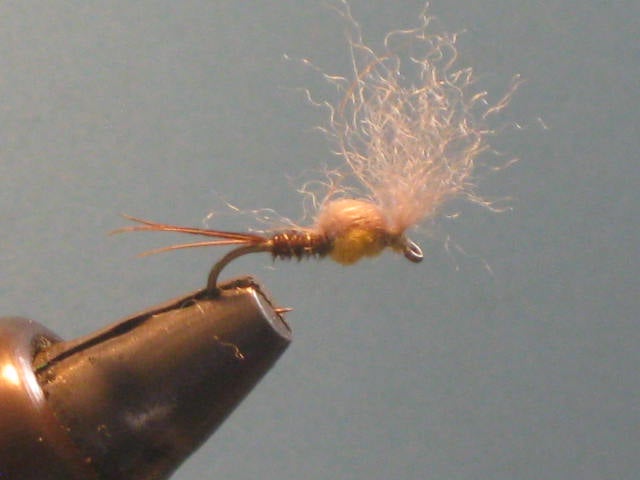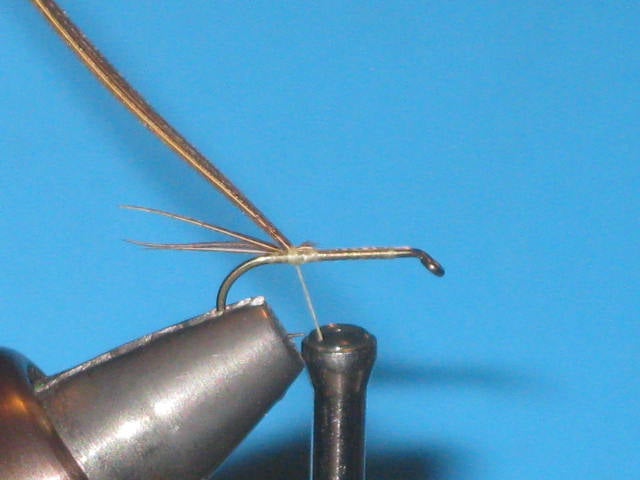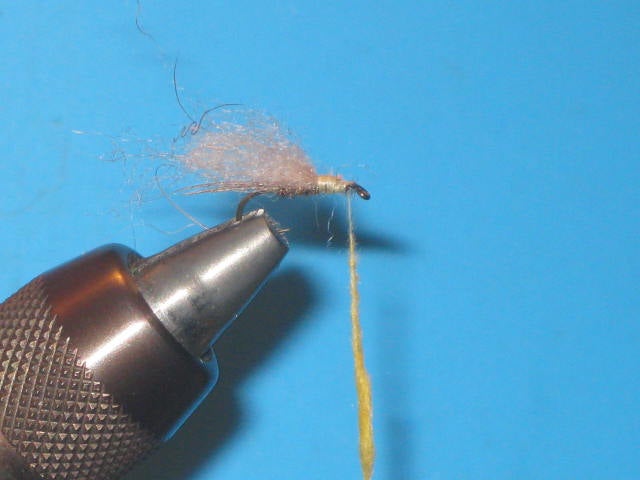peregrines
Super Moderator/Fly Swap Coordinator
- Messages
- 4,009
- Reaction score
- 30
[TABLE="head]{colsp=2}
This pattern can be modified to match naturals of hatches in your area by matching the hook sizes and changing the color/shade of the wing and thorax dubbing. This example is used to imitate one of the eastern mayflies called Sulphurs (Ephemerella dorothea here) in size 16 and 18 |

Type of fly | Emerger mayfly
Originator of pattern if known |
Tied and Submitted by | peregrines
Level of tying experience needed to tie this pattern | Beginner, a very simple and forgiving dry fly pattern using basic tying skills. This pattern is another in our upcoming series of Beginner Trout Fly Tying Lessons. This pattern is tied using the same techniques ads pheasant tail nymph but substitutes a few different materials: A light wire standard Dry Fly hook instead of a heavier wire nymph hook, dry fly dubbing for the thorax instead of peacock herl and the hair from the bottom of a snowshoe hare's foot (not rabbit's foot) for the wing instead of a wingcase of pheasant tail fibers. For an easy to tie dry fly using snowshoe hare see the Usual with recently added step by steps in this pattern library
Materials listed in order of tie in:|
Hook | Dry fly sizes vary to match naturals generally size 16 and smaller
Thread | Danville's Brown 6/0 here
Rib: Fine wire, gold or copper
Tail| 3 pheasant tail fibers, do not cut butts.
Body | Pheasant tail fiber butts from tail
Wing | Hair from snowshoe hare’s foot
Thorax | Dry Fly Dubbing, Super Fine Sulphur Orange for Sulphur Mayflies, Blue WIng Olive (brownish olive) for Blue WInged Olives and Pale Morning Dun ( dirty tannish green) for Pale Moring Duns
Head | Thread
Special tying notes | Rear half of fly is a Pheasant Tail Nymph. Front half represents the emerging mayfly dun crawling out of it's nymphal skin
If you try and find long hair by poking around on the outside of a hare's foot you may get frustrated. Much of the hair will be short. To get at the good stuff-- the longer hair on the bottom of a snowshoe hare’s foot, split the foot between the two bones that run lengthwise down the foot. You should be able to feel the two bones with your thumb. Here i placed a screwdriver between the two bones and gave it a whack with a hammer. You may have to do this 2 or 3 times at different places to split it completely |

Here's a closer pic of a split hare's foot (right) showing improved access to the longer hair on the bottom of the foot, next to an unsplit foot (left)|

Tie on Thread |

Tie on 3 Pheasant Tail fibers, tips extending to rear of fly 1/2 shank length for tail. Do not trim butts, these will be wound up shank to form abdomen. |

Tie in fine wire for rib |

Wind forward the uncut butts from the 3 pheasant tail fibers (that were used for the tail) to form abdomen over rear 3/4 of shank |

Trim butts of pheasant tail fibers and counterrib wire |

Cut a clump of hair from the bottom of a snowshoe hare's foot. Measure hair length of snowshoe hare to 1 shank length and tie in over thorax with tips extending towards rear of fly. |

Trim butts of snowshoe hare and form a thread base over thorax to receive dubbing |

Apply dubbing to thread Sulphur Orange Superfine is used here |

Dub thorax. Note some of the wraps will take you rearwards over a bit of the peacock herl body so that the abdomen forms about 60% of the body instead of the 75% formed earlier, and the thorax will cover 40% of the rest of the body excluding the eye width of bare shank reserved for the head |

Pull hair forward over top of thorax and tie down |

Take a couple of wraps immediately in front of and tight against the wing to prop it up a bit. Form a neat head, whip finish and you're done |

Target species | Trout, should work on panfish too
Fishing notes | An easy to tie and durable pattern that sits flush in the film and. Vary shades and hook sizes of natural and dyed snowshoe hare for the wing and and dubbing for the thorax to imitate the naturals of hatches in your area. This type of pattern is a good choice for Pale Morning Duns and Blue Wing Olives as well as Sulphurs.
[/TABLE]
Pheasant and Hare Emerger Step By Step (SBS)
This pattern can be modified to match naturals of hatches in your area by matching the hook sizes and changing the color/shade of the wing and thorax dubbing. This example is used to imitate one of the eastern mayflies called Sulphurs (Ephemerella dorothea here) in size 16 and 18 |

Type of fly | Emerger mayfly
Originator of pattern if known |
Tied and Submitted by | peregrines
Level of tying experience needed to tie this pattern | Beginner, a very simple and forgiving dry fly pattern using basic tying skills. This pattern is another in our upcoming series of Beginner Trout Fly Tying Lessons. This pattern is tied using the same techniques ads pheasant tail nymph but substitutes a few different materials: A light wire standard Dry Fly hook instead of a heavier wire nymph hook, dry fly dubbing for the thorax instead of peacock herl and the hair from the bottom of a snowshoe hare's foot (not rabbit's foot) for the wing instead of a wingcase of pheasant tail fibers. For an easy to tie dry fly using snowshoe hare see the Usual with recently added step by steps in this pattern library
Materials listed in order of tie in:|
Hook | Dry fly sizes vary to match naturals generally size 16 and smaller
Thread | Danville's Brown 6/0 here
Rib: Fine wire, gold or copper
Tail| 3 pheasant tail fibers, do not cut butts.
Body | Pheasant tail fiber butts from tail
Wing | Hair from snowshoe hare’s foot
Thorax | Dry Fly Dubbing, Super Fine Sulphur Orange for Sulphur Mayflies, Blue WIng Olive (brownish olive) for Blue WInged Olives and Pale Morning Dun ( dirty tannish green) for Pale Moring Duns
Head | Thread
Special tying notes | Rear half of fly is a Pheasant Tail Nymph. Front half represents the emerging mayfly dun crawling out of it's nymphal skin
If you try and find long hair by poking around on the outside of a hare's foot you may get frustrated. Much of the hair will be short. To get at the good stuff-- the longer hair on the bottom of a snowshoe hare’s foot, split the foot between the two bones that run lengthwise down the foot. You should be able to feel the two bones with your thumb. Here i placed a screwdriver between the two bones and gave it a whack with a hammer. You may have to do this 2 or 3 times at different places to split it completely |

Here's a closer pic of a split hare's foot (right) showing improved access to the longer hair on the bottom of the foot, next to an unsplit foot (left)|

Tie on Thread |

Tie on 3 Pheasant Tail fibers, tips extending to rear of fly 1/2 shank length for tail. Do not trim butts, these will be wound up shank to form abdomen. |

Tie in fine wire for rib |

Wind forward the uncut butts from the 3 pheasant tail fibers (that were used for the tail) to form abdomen over rear 3/4 of shank |

Trim butts of pheasant tail fibers and counterrib wire |

Cut a clump of hair from the bottom of a snowshoe hare's foot. Measure hair length of snowshoe hare to 1 shank length and tie in over thorax with tips extending towards rear of fly. |

Trim butts of snowshoe hare and form a thread base over thorax to receive dubbing |

Apply dubbing to thread Sulphur Orange Superfine is used here |

Dub thorax. Note some of the wraps will take you rearwards over a bit of the peacock herl body so that the abdomen forms about 60% of the body instead of the 75% formed earlier, and the thorax will cover 40% of the rest of the body excluding the eye width of bare shank reserved for the head |

Pull hair forward over top of thorax and tie down |

Take a couple of wraps immediately in front of and tight against the wing to prop it up a bit. Form a neat head, whip finish and you're done |

Target species | Trout, should work on panfish too
Fishing notes | An easy to tie and durable pattern that sits flush in the film and. Vary shades and hook sizes of natural and dyed snowshoe hare for the wing and and dubbing for the thorax to imitate the naturals of hatches in your area. This type of pattern is a good choice for Pale Morning Duns and Blue Wing Olives as well as Sulphurs.
[/TABLE]
Last edited:
